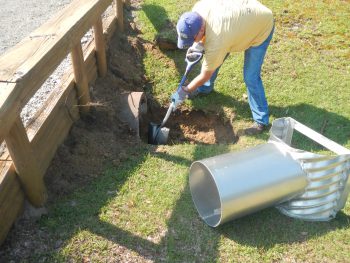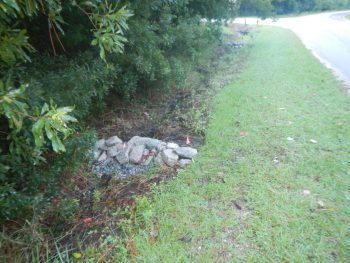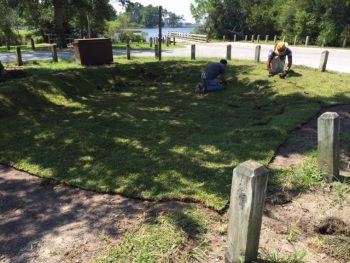New stormwater runoff projects installed in Cedar Point last week will reduce the volume of polluted runoff that flows into the White Oak River.
The best management practices (BMPs) broke ground in the Croatan National Forest and a nearby neighborhood as part of the White Oak watershed restoration plan for impaired waters. Funding for these projects comes from the Environmental Protection Agency under Section 319(h) of the Clean Water Act.
Stormwater runoff picks up bacteria and other pollutants before flowing into coastal waterways. This can result in dangerous bacteria levels, which can lead to closures for shellfish harvesting and swimming.
The federation partnered with Dr. Charlie Humphrey and Dr. Eban Bean of East Carolina University to design, install and monitor a series of BMPs to reduce runoff entering the watershed. Bree Tillett, coastal fellow for the federation, assisted with plan implementation this summer along with Lauren Kolodij, deputy director for the federation, who is the lead on the watershed plan.
Neighborhood Retrofits

Humphrey installs a water control structure into a culvert
In the Ocean Spray neighborhood, Humphrey said his team installed several water control structures in the culverts. Culverts are pipes that carry stormwater, often found underneath driveways.
“They’re putting in water control structures in the culverts that run under the driveways to slow down the water and force it to infiltrate. They had homeowners volunteer for that,” said Tillett.
These water control structures allow placement of a wooden board on the culvert. The board blocks rapid water flow during normal rain events, and prevents stormwater from picking up pollutants and washing them into the White Oak River.
There were also select areas in the neighborhood road right of way where sod was placed. The sod prevents stormwater from eroding the roadside areas as it moves into the adjacent ditches. The extra vegetation will also infiltrate stormwater.
In addition to these BMPs, rain barrels were installed in the Marsh Harbour neighborhood earlier this summer as part of this watershed plan. The barrels catch the rain from gutters, and the water is reused for irrigation.
Croatan National Forest

Check dams were installed along the entrance road to the Cedar Point recreation area to slow down water in the existing swale and aid in infiltration. The check dams are made from rock.
“Check dams” made out of rock were built along the entrance road to the Cedar Point recreation area. These dams help aid infiltration and slow down water flow in the existing swale.
Humphrey and his team also installed a rain garden in a grassy area close to the ramp, which directs polluted stormwater to soak into the ground. Soil and plants will filter out pollutants, and the collected water will infiltrate and recharge the groundwater, and feed into streams and wetlands.

This rain garden will infiltrate water that would otherwise end up in the estuary.
Many of these projects take little time to install, demonstrating the easy ways you can reduce stormwater right at home. Though simple, these retrofits will reduce the volume of the biggest polluter of coastal waters.
Check out our Smart Yards publication to learn more about preventing and reducing stormwater runoff. Smart Yards offers simple, do-it-yourself solutions to reduce stormwater pollution. For more information about the White Oak watershed restoration plan, please contact Lauren Kolodij at 252-393-8185.
